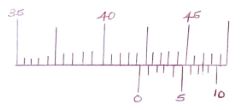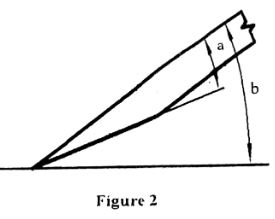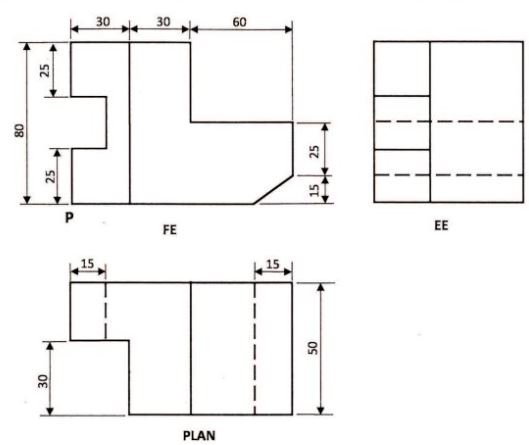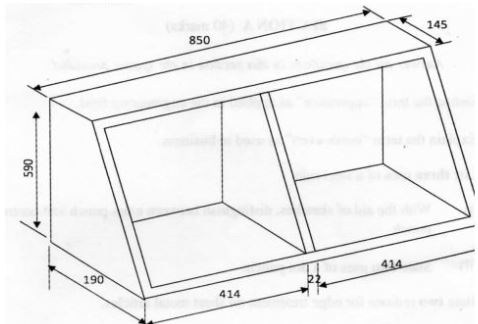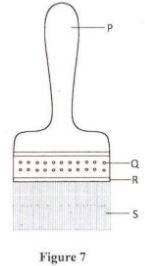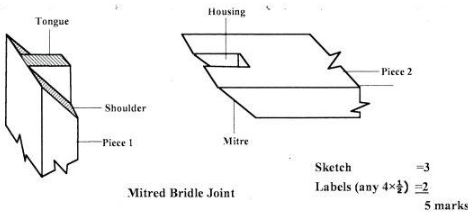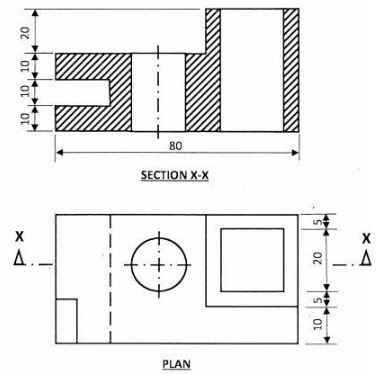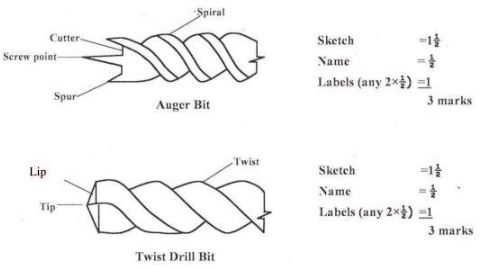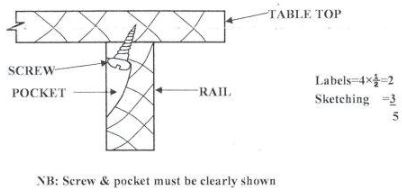Instructions To Candidates
You should have the following for this examination.
- Answer booklet.
- Drawing Instruments.
- Drawing Paper size A3
SECTION A: Answer all the questions.
SECTION B: Answer question 11 and any other 3 questions.

Questions
SECTION A (40 MARKS)
Answer all the questions in this section in the space provided
-
- List four functional requirements of woodwork workshop. (2 marks)
- State three causes of accidents relating to the use of hand tools in a woodwork workshop. (3 marks)
- Explain the cause of each of the following classes of fire.
- Class A fire (2 marks)
- Class B fire (2 marks)
- Figure 1 shows a vernier caliper reading
Determine the value of the reading (2 marks) - State four practices that demonstrate the proper use of a cross-cut saw when cutting timber. (4 marks)
-
- State two functions of the knob on a bench plane (2 marks)
- Sketch the plan of the head to show the shape of the slots on the following types of screw.
- Philips recess (2 marks)
- Coach recess (2 marks)
-
- Sketch and label a try square (2 marks)
- State two uses of a try square (2 marks)
- Figure 2 shows the cutting edge of a chisel
- Name the angles labelled a and b (1 mark)
- Give the recommended value for each of angles in 7(a) (2 marks)
- Sketch each of the following types of treatment given to the edges of tables (3 marks)
- Chamfer
- Bevel
- State four characteristics of varnish applied on a dry wooden surface (4 marks)
- Print the phrase ‘God is Good’ using the vertical capital letters of uniform 7mm height and word spacing of 5mm. (5 marks)
SECTION B (60 marks)
Answer question 11 on A 3 size paper provided and any other three questions from this section in the spaces provided . Candidates are advised Not to spend more than 25 minutes on question 11.
- Figure 3 shows a block in orthorgraphic view, Draw the block in an isometric projection full scale with P the lowest point. (15 marks)
-
- Outline the procedure of making a groove in a workpiece using a plough plane. (7 marks)
- Using labelled sketches, show the difference between an auger bit and a twist drill bit. (6 marks)
- State two precautions to be observed when using a steel tape measure. (2 marks)
-
- State four precautions to be observed when using a steel tape measure. (4 marks)
- State four purposes of a primer coat as used in painting. (4 marks)
- Outline the procedure of marking out a piece of wood to size using a marking gauge. (7 marks)
-
- With the aid of a labelled sketch, show the pocket screw method of fixing table top to rails. (5 marks)
- State six benefits of starting a small scale business in rural areas. (6 marks)
- Other than food, state and explain two favorable conditions for fungal growth in timber. (4 marks)
-
- Figure 4 shows pictorial views of wall mounted shelf. All members are 22 mm thick softwood.
Prepare a cutting list for purchasing the timber required for the shelf. (9 marks) - Figure 5 shows a paint brush.
- Name the parts marked P, Q, R and S.
- State the function of each part. (6 marks)
- P”
- Q”
- R”
- S”
- Figure 4 shows pictorial views of wall mounted shelf. All members are 22 mm thick softwood.

Marking Scheme
-
- Sources of business capital.
- Loans from financial institutions.
- Personal savings.
- Family shares.
- Donations from friends.
- Pulling resources together.
- Factors to consider when starting a business.
- Market.
- Infrastructure.
- Availability of raw materials.
- Cultural values.
- Security of the locality.
- Sources of business capital.
-
- Dangers of inhaling toxic adhesives
- Blurred vision.
- Difficulty in breathing.
- Brain damage.
- Headache.
- Memory loss.
- Death.
- Characteristics of softwood trees.
- Seeds are enclosed in cones.
- Needle like leaves.
- Evergreen.
- Mature faster.
- Seeds have wings.
- Dangers of inhaling toxic adhesives
-
- Reasons that make a mortice gauge produce inaccurate marks.
- Loose spurs.
- Loose thumbscrew.
- If the stem is worn out.
- If the stock hole is not tightly fitting the stem.
- If accurate readings were not taken before locking the thumb screw.
- Reasons that make a mortice gauge produce inaccurate marks.
- Timber defects
-
- A - upset
B - waney edge
- A - upset
- Causes of upsets
- Fracturing of the Wood fibres across the grain.
- Caused by sudden shock at the time of felling.
- Tree becoming over stressed during growth.
- Tree being bent by strong winds.
- Causes of Waney edge
- Uneven growth and size of the tree. This refers to the edge of a piece of timber which has retained part of the bark after conversion.
- Too economical conversion.
-
-
- Practices that demonstrate the correct use of a cross-cut hand saw.
- Pull the saw towards your body to start the cut.
- Take short, light strokes, gradually increasing the strokes to full length of the saw.
- Use the saw at an angle of approximately 45” with the face of the board.
- Keep the saw in line with the forearm.
- Keep the saw plumb with the face of the board.
- Do not force or jerk the saw while in use.
- Hold the saw in one hand and extend the first finger along the handle.
- Keep your eye on the line rather than on the saw while working.
- Parts of a circular saw.
- A - Riving knife.
- Saw blade.
- Saw guard.
- Fence.
- Practices that demonstrate the correct use of a cross-cut hand saw.
-
- Functions of the knob in a bench plane.
- The knob allows the user to control and direct the plane with both hands.
- It allows the user to hold and leverage the plane during use.
- Precautions to be observed when using a lathe machine.
- Select the correct speed for the work to be turned.
- Ensure the work is secured to the face plate or between centres.
- Spin work by hand to ensure that it clears the lathe bed and tool rest.
- Always return tools to the tray - do not place them on the bed of the lathe.
- Wear protective clothing.
- Characteristics of polyvinyl actate (PVA) glue.
- Easily applied.
- Sets at room temperature.
- Does not stain.
- Sets clearly and does not damage the edge of tools.
- Water resistant.
- Disadvantages of oil based paint.
- Flammable.
- Produces an odour when newly applied.
- Requires a thinner therefore more expensive.
- Exploded pictorial view of a mitred bridle joint.
-
-
- Procedure of making a groove.
- Mark the work piece.
- Clamp the work piece.
- Set blade to depth.
- Set the fence.
- Identify direction of grain.
- Make first cut gently.
- Make deep cut.
7 marks
- Procedure of carving.
- Prepare the template.
- Transfer the outline onto the work piece.
- Hold the work piece on the vice.
- Carve the hollow part of the dish.
- Carve the shape of the neck.
- Shape the base.
- Finish the surfaces of the dish to the required texture.
8 marks
- Procedure of making a groove.
-
- Difference between auger bit and twist drill bit.
- Oven dry method of moisture content determination.
- A small sample of wood is cut from the batch of timber to be dried.
- The sample is weighed to determine the initial or wet weight.
- It is then placed in a special drying oven and left until no further Weight loss can be recorded.
- The final or dry weight is noted.
- The percentage moisture content is calculated using the formula.
- initial (wet) weight - final (dry) weight
- Film forming finishes form a thin layer over the surface to Which they are applied eg. paints, varnishes, Wax.
- Penetrating finishes are absorbed into the wood, saturating the fibres and partially or completely filling the surface pores. eg. Water repellants, stains, spirits. Total 4 marks
- Difference between auger bit and twist drill bit.
-
- Procedure of marking out
- Ensure one face or edge is true.
- Set the gauge to the required size using a rule.
- Tighten the thumb screw.
- Hold the Wood at an angle and press the gauge stock against the side.
- Tilt the gauge to let the spur trail.
- Move the gauge along the length of the wood.
- The spur point will cut a line as it goes alone. 7 marks
- Cost of coffee stool
- Block board
- Assume full board is used
3600 =900
Lipping top + base = _ >< 500 + >< 200
: 1571+ 628 : 2199 Q 2200 mm
i.e. lengths Q 8
Cost of lipping 30 x 8 = 240 ©
Stand length = 450 ie. 2 lengths
Cost of stand 2 x 40 = 80 Cg
Glue 1/2kg 60/= =60
Wood varnish f kg @ 180 fig
1,460
Add 30% for labour and overheads 438
Cost of materials Ksh 1323 Cg
- Procedure of marking out
-
- Pocket screw method of fixing table top.
- Parts of brush and function
- Part Function
- P - handle - to hold brush.
- Q - ferrule - connects handle to bristles
- - plug - holds and spreads the bristles.
- - bristles - spread the paint
- Favourable conditions for fungal growth.
- Moisture in wood - must be above 20%
- Temperature - between 30 - 37°C. Lower temperatures may reduce growth higher temperatures will kill fungi.
- Air - essential requirement for growth and respiration.
- Pocket screw method of fixing table top.
Download Wood Work Paper 1 Questions and Answers - Bunamfan Cluster Pre Mock Exam 2022.
Tap Here to Download for 50/-
Get on WhatsApp for 50/-
Why download?
- ✔ To read offline at any time.
- ✔ To Print at your convenience
- ✔ Share Easily with Friends / Students

